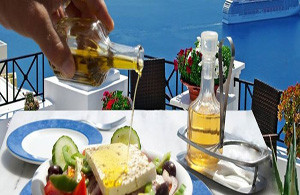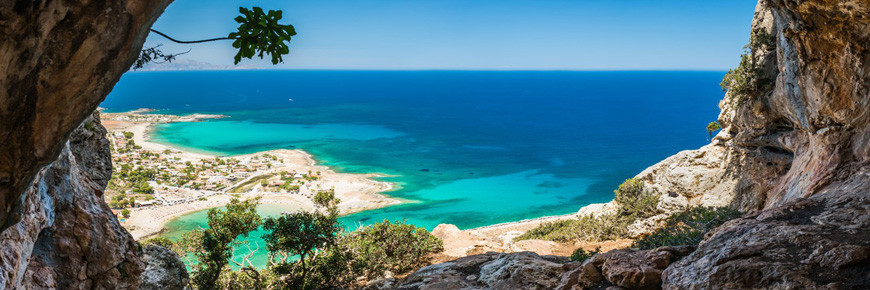
Information about Crete
Everything you need to know before you visit
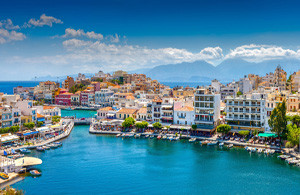 Crete subscribes to the bigger is better school of thought. Not only is it the largest of the Greek Islands, but it’s the 5th biggest island in the Mediterranean Sea – Corsica pips it to the 4th place post by just a few hundred acres.
Crete subscribes to the bigger is better school of thought. Not only is it the largest of the Greek Islands, but it’s the 5th biggest island in the Mediterranean Sea – Corsica pips it to the 4th place post by just a few hundred acres.
Crete’s super-size means it’s got 650 miles of coastline to go around. The beaches in the Lassithi area, to the east of the island, are annexes to the cosmopolitan towns of Agios Nikolaos and Elounda. Here, sunbathers can mix stints on the sunbed with shopping sprees and long lunches in the squares. Further west, the Chania area teams Blue Flag beaches with an historical old town. The 12-kilometre-plus swathes of sand in the Rethymnon area are covered with the footprints of families, while the beaches in the Heraklion area are the staging areas and recovery spots for nights on the tiles.
Eating Out
Crete is known for using fresh, local produce in their delicious island delicacies: Pure olive oil, sweet-vine tomatoes and a hint of garlic make up the base for most of these. Cretan Plaki, freshly caught fish baked with tomatoes and a lemony parsley sauce is a classic speciality. Shrimp saganaki (hot shrimps baked in cheese) is best enjoyed with a glass of the grappa-like Cretan raki. Try the traditional crunchy filo parcels - tyropites - bursting with chunks of feta cheese and sprinkled with sesame seeds. Or, the Sfakianopita, a crepe-like, pan-fried pie filled with creamy Myzithra cheese and served with a spoonful of pure Cretan thyme honey.
Things to see and do in Crete
Sight Seeing
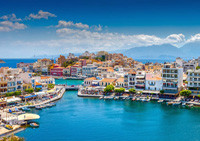 South-west of Crete’s capital town, you’ll find the gigantic man-made caves sheltering Matala Beach’s golden sands. Inhabited by “flower children” from all over the world in the 60s and 70s and dating back to the Roman times, these aren’t the only archaeological treasure you’ll discover here. Put on your snorkels and explore the fantastic Roman-era remains found underwater too! Head north-east from here for a visit to Crete’s best place for mythology-lovers: the Palace of Knossos - or the palace of the Minotaur, according to Greek mythology. Stroll around the remains of royal underground rooms, intricate pillars and colorful wall paintings, taking.
South-west of Crete’s capital town, you’ll find the gigantic man-made caves sheltering Matala Beach’s golden sands. Inhabited by “flower children” from all over the world in the 60s and 70s and dating back to the Roman times, these aren’t the only archaeological treasure you’ll discover here. Put on your snorkels and explore the fantastic Roman-era remains found underwater too! Head north-east from here for a visit to Crete’s best place for mythology-lovers: the Palace of Knossos - or the palace of the Minotaur, according to Greek mythology. Stroll around the remains of royal underground rooms, intricate pillars and colorful wall paintings, taking.
An Island of Beaches
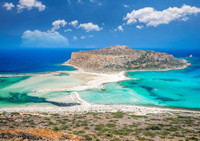 Head to the southern tip and soak up the sun on Elafonisi Beach’s pink sands. Drenched by the Libyan Sea’s warm, shallow waters, its soft beach got its peculiar colour from thousands of years of corals crumbling naturally into sand-like grains. Known as the “Greek Caribbean”, the transparent waters here are definitely worth the sunny drive up and downhill. If you find yourself on the northern tip, don’t miss out on visiting Crete’s number one attraction: Vai’s Blue Flag beach. Shaded by Europe’s largest natural palm-tree forest, its golden sands offer another exotic beach spot, complete with windsurfing and group scuba diving.
Head to the southern tip and soak up the sun on Elafonisi Beach’s pink sands. Drenched by the Libyan Sea’s warm, shallow waters, its soft beach got its peculiar colour from thousands of years of corals crumbling naturally into sand-like grains. Known as the “Greek Caribbean”, the transparent waters here are definitely worth the sunny drive up and downhill. If you find yourself on the northern tip, don’t miss out on visiting Crete’s number one attraction: Vai’s Blue Flag beach. Shaded by Europe’s largest natural palm-tree forest, its golden sands offer another exotic beach spot, complete with windsurfing and group scuba diving.
Discover the West
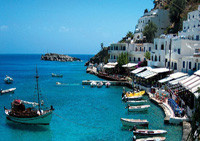 Crete’s western corner offers up some fantastic history and scenery. And this day trip is great for taking it all in. Your first stop is the World War II cemetery at Souda Bay. With its green lawns edging the bay’s shores, this poignant place is home to over 1,500 graves of British and Commonwealth soldiers who died here during the 1941 Battle of Crete.
Crete’s western corner offers up some fantastic history and scenery. And this day trip is great for taking it all in. Your first stop is the World War II cemetery at Souda Bay. With its green lawns edging the bay’s shores, this poignant place is home to over 1,500 graves of British and Commonwealth soldiers who died here during the 1941 Battle of Crete.
After visiting the nearby grave of Crete’s national hero, Eleftherios Venizelos, you’ll then continue on to Chania. Set around an old harbour and threaded with cobbled lanes, it’s one of Crete most beautiful harbor towns. After a guided tour, you’ll get the chance for a spot of shopping, perhaps snapping up leather goods along the town’s famous ‘Leather Lane’. Before the trips ends you'll drive to Lake Kournas - Crete's biggest lake. Here you'll have a bit of time to relax and take in the the views, before heading back to base.
Frangokastello
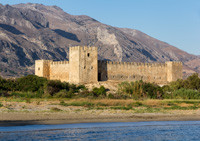 Frangokastello is an important historical monument in the region of Chania, Crete. This castle was built between the period 1371-1374 BC. The construction work started by the Venetians, who had conquered Crete that time. In fact, this castle was set up to maintain a military base for the Venetian army. Apart from protecting the area and the properties of the noblemen from pirates and enemy attacks, this castle would also be used as a base for attacks in the inland of Crete, who was still resisting to the Venetian conquerors. At first, the castle was named Castle of Saint Nikitas to honor a close church, but later it was named Frangokastello by the locals, which means the Castle of the Franks (Venetians).
Frangokastello is an important historical monument in the region of Chania, Crete. This castle was built between the period 1371-1374 BC. The construction work started by the Venetians, who had conquered Crete that time. In fact, this castle was set up to maintain a military base for the Venetian army. Apart from protecting the area and the properties of the noblemen from pirates and enemy attacks, this castle would also be used as a base for attacks in the inland of Crete, who was still resisting to the Venetian conquerors. At first, the castle was named Castle of Saint Nikitas to honor a close church, but later it was named Frangokastello by the locals, which means the Castle of the Franks (Venetians).
The Venetians constructed Frangokastello in a rectangular shape. They built strong and massive towers at each of the four corners. On the huge gate, they built a coat of arms symbolizing the Venetian bravery. However, all the buildings and fortifications that we see today inside the castle walls were completed by the Turks during the Ottoman rule (17th-19th centuries). Another legend connected to Frangokastello is the story of Drossoulites. In 1828, the Cretans had revolved against the Turks and 600 men from Epirus under Hatzi Michalis Dalianis had come to help the Cretan Revolution. In May 1828, they locked themselves in Frangokastello, rejecting the advice of the Cretans that this was not a safe location. Outside the walls, there were 8,000 Turkish soldiers fighting them.
Lake Voulismeni
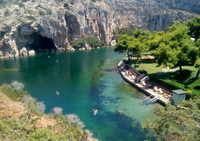 Right in the heart of the resort, you’ll discover magical Lake Voulismeni. According to mythology, this is where the goddess Athena used to bathe, and today you can do the same in this truly magnificent setting. The picturesque saltwater lake is lined with pastel-colored tavernas and stylish boutiques, so it’s easy to while away a whole day and evening here. You won’t want to miss this.
Right in the heart of the resort, you’ll discover magical Lake Voulismeni. According to mythology, this is where the goddess Athena used to bathe, and today you can do the same in this truly magnificent setting. The picturesque saltwater lake is lined with pastel-colored tavernas and stylish boutiques, so it’s easy to while away a whole day and evening here. You won’t want to miss this.
Heraklion
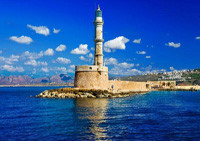 The region of Heraklion Crete gets very popular in summer as this is the main transportation hub to Crete. In fact, many charter flights from abroad and ferries arrive in Heraklion Town, carrying millions of visitors. Holidays in Heraklion combine amazing beach resorts with visit to historical sites. The northern side of the region is very developed with tourist facilities, especially the beach places close to Heraklion Town. The southern side is more secluded and receives fewer visitors but it has famous places, like Matala.
The region of Heraklion Crete gets very popular in summer as this is the main transportation hub to Crete. In fact, many charter flights from abroad and ferries arrive in Heraklion Town, carrying millions of visitors. Holidays in Heraklion combine amazing beach resorts with visit to historical sites. The northern side of the region is very developed with tourist facilities, especially the beach places close to Heraklion Town. The southern side is more secluded and receives fewer visitors but it has famous places, like Matala.
Located between the prefectures of Rethymno and Lassithi, on the eastern side of Crete, Heraklion is the most popular region of the island. It hosts many busy places with intense nightlife, including Malia, Hersonissos, Ammoudara and Agia Pelagia, but also many peaceful family places, particularly on the southern side. As Heraklion Greece was the main field where the Minoan civilization flourished, you should not miss a visit to the Minoan Palaces of Knossos and Phaestos. A drive around Heraklion in Crete will also bring you to traditional villages, Medieval castles, Byzantine monasteries and nice beach places to relax. This region combines busy resorts and secluded coves.
In the 16th century, Heraklion was conquered by the Turks who kept the entire island under their occupation till the early 20th century. In fact, the town has signs of the Venetian and the Turkish occupation in its architecture structures. The area of Heraklion is green and very interesting. Pure nature gives way to mountainous villages and sandy beaches are followed by impressive gorges. Driving around the prefecture is an excellent experience to get to know the Cretan landscape. Heraklion has developed a lot in tourism. Most famous tourist resorts are Malia, famous for their vivid nightlife, Hersonissos and Agia Pelagia, while Matala on the southern side of Crete is also much developed. The relaxing sandy beaches and the picturesque villages have made Heraklion a popular tourism destination in Crete.
Popular Resorts of Crete
Elounda
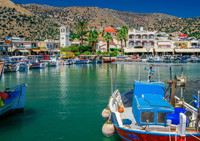 Elounda is a seaside town on Crete’s northwestern coast. It’s an up-and-coming retreat that revolves around a colourful harbour and the main square just next door. The place is packed with authentic Greek tavernas and friendly bars – it also comes with a sandy beach that looks out to the fascinating Spinalonga Island. It’s quite a lively spot, but if you want a little bit more more action there’s Agios Nikolaos just 15 minutes’ drive away.
Elounda is a seaside town on Crete’s northwestern coast. It’s an up-and-coming retreat that revolves around a colourful harbour and the main square just next door. The place is packed with authentic Greek tavernas and friendly bars – it also comes with a sandy beach that looks out to the fascinating Spinalonga Island. It’s quite a lively spot, but if you want a little bit more more action there’s Agios Nikolaos just 15 minutes’ drive away.
Elounda’s main beach, just a short walk from the harbour is a 200-metre stretch of golden sand. It has the Blue Flag for cleanliness, as does the quieter Driros Beach, a 15-minute walk south along the coastal path. Or if you’ve got a car, a 5-minute drive takes you to the pebble beach at Plaka, which comes with a promenade. A short walk south will bring you to the causeway connecting Elounda to Spinalonga Island– it’s here you’ll see the only remains of the submerged ancient city of Olous. Five huge stone windmills were excavated and today they stand next to the bridge, open to the public to walk around.
Chania
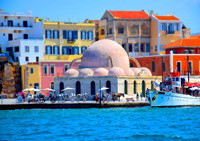 Chania is one of the oldest towns in Crete, with lots of history behind it. Famous for its preservable settlement with the remarkable monuments and houses from the Venetian times, this authentic town is considered quite lively and definitely picturesque for its mystical character and traditional beauty. Chania consists of two settlements, the old and the new town which still exist to this day. It combines tradition with tourism and suits for all types of holiday. The friendly atmosphere and warm hospitality of Chania guarantee a unique holiday experience. The Venetian port lies in the heart of the old town town, surrounded by picturesque alleys and streets creating an idyllic area and unique atmosphere.
Chania is one of the oldest towns in Crete, with lots of history behind it. Famous for its preservable settlement with the remarkable monuments and houses from the Venetian times, this authentic town is considered quite lively and definitely picturesque for its mystical character and traditional beauty. Chania consists of two settlements, the old and the new town which still exist to this day. It combines tradition with tourism and suits for all types of holiday. The friendly atmosphere and warm hospitality of Chania guarantee a unique holiday experience. The Venetian port lies in the heart of the old town town, surrounded by picturesque alleys and streets creating an idyllic area and unique atmosphere.
The old town consists of well preserved and restored mansions that have been converted to tavernas, local shops and restaurants. The old town has many quarters and squares to walk surrounded by ancient buildings and mosques which are worth admiring. The aristocratic neighborhood is full of beautiful Venetian buildings worth seeing. Chania offers many types of accommodations, numerous international restaurants and Greek traditional tavernas, excellent pastry shops, traditional cafes, lively bars, clubs and pubs, all mostly located in the harbor area, cinemas, theaters and places for concerts and exhibitions, and plenty of cultural activities that take place in the beautiful town.
Agios Nikolaos
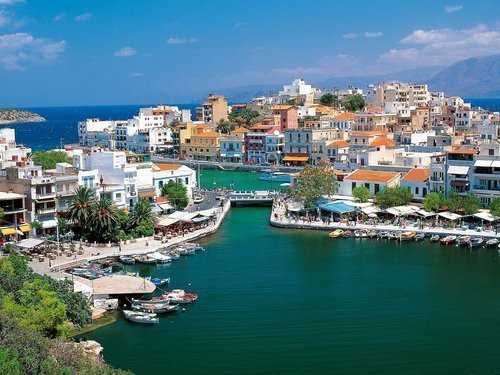 Different to all other towns in Crete, Aghios Nikolaos is an arty, leisurely, sleepy and yet also bustling place, a medium-size town with a small-town feel, one that has lots to offer. Whether you’re a beach lover or a night owl, you’re sure to find something for you in the vibrant resort. This charming, activity-packed town caters to the needs of all who visit. From the resort, you can go on many day trips, such as visiting an olive farm or the Monastery of Faneromeni, meaning you’re sure to come away with some great memories. And with so many tavernas and nightclubs in Aghios Nikolaos itself, you’ll have plenty to do when the sun goes down too.
Different to all other towns in Crete, Aghios Nikolaos is an arty, leisurely, sleepy and yet also bustling place, a medium-size town with a small-town feel, one that has lots to offer. Whether you’re a beach lover or a night owl, you’re sure to find something for you in the vibrant resort. This charming, activity-packed town caters to the needs of all who visit. From the resort, you can go on many day trips, such as visiting an olive farm or the Monastery of Faneromeni, meaning you’re sure to come away with some great memories. And with so many tavernas and nightclubs in Aghios Nikolaos itself, you’ll have plenty to do when the sun goes down too.
Sfakia Village
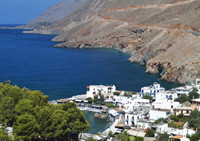 The historical village of Sfakia is built on the hills, overlooking the bay. It is situated around the White Mountains range and the Samaria Gorge. Sfakia lies 72 km south east of Chania town. Most of the inhabitants here are involved in fishing and goat raining producing delightful cheeses such as anthotiri or mizithra. The main town of Sfakia constitutes an excellent place to start your exploration of the southern coast of Crete. The village is very traditional and authentic and its calm atmosphere is only interrupted during the afternoon by the arrivals of hikers coming from the Samaria Gorge with small boats.
The historical village of Sfakia is built on the hills, overlooking the bay. It is situated around the White Mountains range and the Samaria Gorge. Sfakia lies 72 km south east of Chania town. Most of the inhabitants here are involved in fishing and goat raining producing delightful cheeses such as anthotiri or mizithra. The main town of Sfakia constitutes an excellent place to start your exploration of the southern coast of Crete. The village is very traditional and authentic and its calm atmosphere is only interrupted during the afternoon by the arrivals of hikers coming from the Samaria Gorge with small boats.
The village is known for its local cuisine and a few excellent restaurants can be found on the seafront and inside Chora. The picturesque port of Sfakia is surrounded by many cafes and fish tavernas and nearby is the main beach of Sfakia which is an excellent choice for swimming. This part of Crete is linked regularly with the town of Chania.
Balos Beach
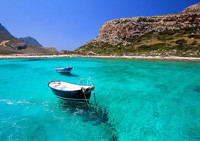 Balos is among the best beaches in Greece and one of the most beautiful beaches in Crete and lies 60 km north west of Chania Town. It is seen as a lagoon from the hills above the beach. Balos has white sand and crystal waters. Opposite the beach, there is a rocky island called Gramvoussa and on top of this island, there is a steep Venetian castle with gorgeous view to the region and the sea. Balos is reached trough a track road from Kaliviani, a village close to Kissamos. This track road is about 10 km and can be crossed by a 4-wheel car. Otherwise, visitors can go by excursion boat from Kissamos.
Balos is among the best beaches in Greece and one of the most beautiful beaches in Crete and lies 60 km north west of Chania Town. It is seen as a lagoon from the hills above the beach. Balos has white sand and crystal waters. Opposite the beach, there is a rocky island called Gramvoussa and on top of this island, there is a steep Venetian castle with gorgeous view to the region and the sea. Balos is reached trough a track road from Kaliviani, a village close to Kissamos. This track road is about 10 km and can be crossed by a 4-wheel car. Otherwise, visitors can go by excursion boat from Kissamos.
Samaria Gorge
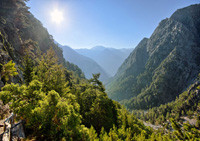 The Samaria Gorge lies on the south side of Chania and is a great place for hikers. Visitors from all over the world attempt trekking at this gorge. In 1962, Samaria Gorge was declared a National Park for the survival of the endangered species kri kri, the rare Cretan wild goat that lives only in Samaria. Apart from the kri-kri, many other endemic and rare species of flora and fauna live in this gorge. A small village used to be there, Samaria village, but it was abandoned by all its inhabitants in 1962, to make the gorge a national park. The village and the gorge were named after the church of Santa Maria that is found inside the gorge.
The Samaria Gorge lies on the south side of Chania and is a great place for hikers. Visitors from all over the world attempt trekking at this gorge. In 1962, Samaria Gorge was declared a National Park for the survival of the endangered species kri kri, the rare Cretan wild goat that lives only in Samaria. Apart from the kri-kri, many other endemic and rare species of flora and fauna live in this gorge. A small village used to be there, Samaria village, but it was abandoned by all its inhabitants in 1962, to make the gorge a national park. The village and the gorge were named after the church of Santa Maria that is found inside the gorge.



